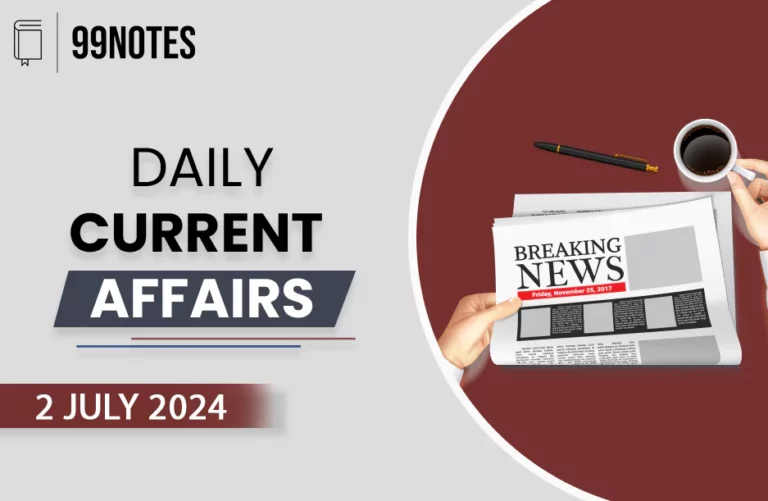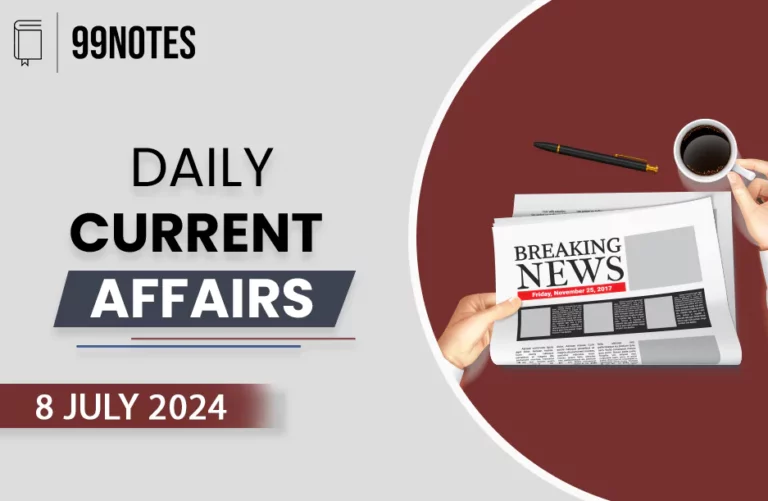17 November 2023 : Daily Current Affairs
Daily Current Affairs
17-November-2023
1. UNSC seeks ‘humanitarian pauses, corridors’ in Gaza
Topic: GS2 – International relations.
Context:
- UN Security Council calls for “extended humanitarian pauses” in Gaza Strip amid Israel-Hamas conflict.
- Israel suggests a pause is contingent on the release of hostages held by Hamas.
Additional information on this news:
- Resolution, prepared by Malta, adopted with 12 votes in favor; U.S., U.K., and Russia abstain.
- The text raises questions about the duration of the pause, with a previous version suggesting five consecutive days.
- Emphasis on allowing aid to reach civilians and compliance with international humanitarian obligations.
- Resolution calls for the immediate and unconditional release of over 230 hostages held by Hamas.
- However, the resolution does not condemn the cross-border attack by Hamas militants on October 7, which resulted in around 1,200 deaths, according to Israeli authorities.
2. Fake doctors were conducting illegal abortions: police
Topic: GS3 – Health sector
Context:
- Police investigation into the fake doctors racket at Agarwal Medical Centre, Greater Kailash-I, reveals multiple cases of illegal sex determination linked to abortions.
- Further investigations reveal a connection between the clinic and illegal sex determination procedures leading to multiple cases of abortions.
Issue of illegal abortions in India:
Introduction
- Unsafe abortions are a major public health concern in India, accounting for a significant proportion of maternal mortality and morbidity.
- The prevalence of illegal abortions stems from various factors, including lack of access to safe and legal abortion services, societal stigma associated with abortion, and restrictive abortion laws.
Factors Contributing to Illegal Abortions
- Limited access to safe and legal abortion services:Many women in India, particularly those in rural areas, lack access to safe and legal abortion services due to geographical barriers, inadequate healthcare infrastructure, and a shortage of trained healthcare providers.
- Societal stigma associated with abortion: Abortion remains a taboo subject in Indian society, leading to women seeking clandestine abortions from unqualified providers, often in unsafe conditions.
- Restrictive abortion laws:The Indian Penal Code (IPC) allows abortion only under certain circumstances, such as when the pregnancy poses a risk to the mother’s life or when the pregnancy is the result of rape or incest.
Consequences of Illegal Abortions
- Maternal mortality and morbidity:Unsafe abortions are a major cause of maternal mortality and morbidity in India. Women who undergo unsafe abortions are at increased risk of complications such as haemorrhage, infection, and organ damage.
- Psychological trauma:The emotional and psychological trauma associated with unsafe abortions can be profound, leading to anxiety, depression, and post-traumatic stress disorder (PTSD).
Measures to Address Illegal Abortions
- Expanding access to safe and legal abortion services:This includes increasing the availability of trained healthcare providers, establishing well-equipped abortion clinics, and providing transportation and accommodation support for women seeking abortion services.
- Raising awareness and reducing stigma:Comprehensive sex education should be integrated into school curricula to provide accurate information about reproductive health and abortion.
- Revising abortion laws: The IPC’s stringent abortion laws should be reviewed and updated to reflect modern medical practices and women’s reproductive rights.
Conclusion
- Addressing the issue of illegal abortions requires a comprehensive approach that tackles the root causes, including lack of access, societal stigma,and restrictive laws.
- By expanding access to safe and legal abortion services, raising awareness, and reforming abortion laws, India can significantly reduce the prevalence of unsafe abortions and improve maternal health outcomes.
Question: Discuss the factors contributing to the prevalence of illegal abortions in India and propose measures to address this public health concern.
3. Centre sworn to improving efficiency in tax administration: Nirmala Sitharaman
Topic: GS3 – Indian economy
Context:
- Union Finance Minister Nirmala Sitharaman emphasizes the Central government’s commitment to infrastructure and tax administration efficiency.
Issue of efficiency in text administration in India
Introduction
- Text administration,the management of documents and records, forms the backbone of governance in India.
- However, the current system faces challenges such as manual processing, outdated technology, and a lack of standardization.
Current Challenges in Text Administration
- Manual processing:A significant portion of text administration in India relies on manual processing, leading to delays, inefficiencies, and errors.
- Outdated technology:The use of antiquated technology and systems hinders the adoption of modern automation and digitization tools.
- Lack of standardization:The absence of standardized procedures and formats for document creation, storage, and retrieval creates inconsistencies and hinders efficient information access.
Strategies to Enhance Efficiency
- Digitization and automation:Transitioning from paper-based records to digital formats and implementing automation tools can streamline processes and reduce manual workload.
- Adoption of cloud computing: Cloud-based solutions offer scalability, security, and accessibility, enabling seamless document sharing and collaboration across departments and agencies.
- Standardization of procedures and formats:Implementing standardized procedures for document creation, classification, and storage facilitates efficient retrieval and analysis.
Additional Measures
- Capacity building and training:Providing training to government officials on digital technologies and record management practices is crucial for effective implementation.
- Modernization of infrastructure:Upgrading IT infrastructure and investing in robust and secure systems are essential to support the digital transformation of text administration.
- Public awareness and engagement:Educating citizens about the benefits of digital record keeping and encouraging online service delivery can promote greater efficiency and transparency.
Conclusion
- Enhancing efficiency in text administration requires a comprehensive approach that addresses both technological and procedural aspects.
- By embracing digitization, automation,and standardization, India can streamline governance processes, reduce administrative costs, and improve citizen service delivery.
4. On the sub-categorisation within castes
Topic: GS2 – Indian Polity
Context:
- PM Narendra Modi promises to explore sub-categorization of Scheduled Castes (SCs) in an election rally in Telangana.
- Move seen as an attempt by the BJP to woo the Madiga community in Telangana, particularly addressing their concerns.
Legality of Sub-Categorization:
- Multiple states, including Punjab, Bihar, and Tamil Nadu, attempted state-level reservation laws for sub-categorizing SCs, facing legal challenges.
- The Supreme Court, in a 2004 judgment, ruled that states couldn’t unilaterally sub-categorize SCs; the matter remains pending in courts.
- A 2020 judgment suggested that deciding on benefits within the existing SCs/STs lists might be permissible, creating a legal contradiction.
Government Initiatives:
- In 2005, the Union government explored legal options for SC sub-categorization based on the Attorney-General’s opinion.
- A National Commission was formed to examine sub-categorization in Andhra Pradesh; a constitutional amendment to Article 341 was recommended but faced differing opinions from SC and ST Commissions.
Arguments for Sub-Categorization:
- Principal argument: Graded inequalities exist among SC communities, and sub-categorization aims to address this.
- More backward SCs face challenges in availing benefits due to crowding out by relatively more forward communities.
- Sub-categorization intends to provide separate reservation for the more backward communities within the SC category.
Counterarguments and Recommendations:
- SC and ST Commissions argue that separate reservations within categories may not address the root cause of inequalities.
- Existing schemes and government benefits should reach the most backward SCs before considering sub-categorization.
- Need for concrete data, including population numbers and socio-economic data, to support sub-categorization decisions.
Conclusion:
- The issue remains legally complex, involving contradictions in judgments, differing opinions, and the need for comprehensive data.
- Concrete steps and clear criteria are essential for addressing the concerns of various SC communities and ensuring effective sub-categorization.
5. Unimpeded freedom of navigation vital: Rajnath
Topic: GS2 – defence sector
Context:
- India’s Defence Minister Rajnath Singh reaffirmed India’s commitment to freedom of navigation, overflight, and unimpeded lawful commerce in international waters at the ASEAN Defence Ministers’ Meeting-Plus (ADMM-Plus) in Jakarta, Indonesia.
Views expressed by the defence minister:
- The defence minister called for regional security initiatives that are consultative and development-oriented, and expressed commitment towards nurturing practical, forward-looking and result-oriented cooperation with ADMM-Plus for enhancing maritime security in the region.
- India also proposed to co-chair the expert working group on counter-terrorism, which was endorsed by ADMM-Plus.
- Singh called for active collaboration among ASEAN and Plus countries.
- He reiterated India’s commitment to work with ASEAN and Plus countries to ensure peace, prosperity, and security.
6. Is it better to eat plant-based foods than rely on meat?
Topic: GS3 – Health
Context:
- A recent article in BMC Medicine looked at the evidence of substituting animal-based foods with plant-based foods and found that it can lower the risk of cardiovascular diseases, type 2 diabetes, and mortality.
What does the article say?
- The article looked at 37 publications based on 24 cohorts and the authors did their own calculations such as the summary hazard ratios and confidence intervals using random-effects meta-analyses. They also assessed the certainty of evidence (CoE) using the GRADE approach.
- The authors acknowledged some limitations, such as the fact that only a few studies were available for some meta-analyses. They also acknowledged that more research is needed on the substitution of subtypes of dairy products with plant-based foods.
- Two dieticians agreed with the findings of the study and said that plant-based foods can improve gut health, lower the risk of diabetes, and improve cardiovascular health.
- They also said that processed meat is the worst culprit, as it contains added sodium and preservatives.
- They recommend that people who want to eat a plant-based diet should talk to a qualified dietician to make sure they are getting all the nutrients they need.
7. India and the US-China truce
Topic: GS2- IR
Context:
- The goal of the most recent summit in San Francisco between Chinese leader Xi Jinping and US President Joe Biden was to halt the deterioration of their bilateral ties.
- All major powers are closely watching developments in the U.S.-China relationship because of its global significance.
- Although there were no significant concerns resolved during the four-hour meeting, the leaders’ tone became more amicable.
India’s Concerns on U.S.-China Collaboration and AI Regulation:
- Though India is still wary of possible Sino-American cooperation in Asia, the summit was more about a ceasefire in the tense relationship than a strategic alliance.
- India needs to keep a careful eye on areas of U.S.-China cooperation, particularly when it comes to artificial intelligence (AI) regulation.
- The mutual understanding on AI between the two countries may eventually have a big impact on international AI laws.
Economic Considerations for India:
- President Xi’s attempts to attract American business leaders back to China deserve India’s attention.
- India shouldn’t believe that the “China option” is no longer a possibility for Western companies, even with possible promises.
- New Delhi still sees productive engagement with Western capital as a top goal.
Indo-Pacific and Regional Security:
- India must keep an eye on the consequences of talks about regional security, particularly as they relate to the Indo-Pacific, the Middle East, and the European conflict in Ukraine.
- The difficulties in the regional security discourse are highlighted by the lack of progress on delicate matters like Taiwan.
China’s Shift and U.S. Strategy:
- The United States views Xi’s decision to reestablish high-level military and political interactions with it as a victory in defining the parameters of engagement.
- With slowdown and economic challenges, China seems to be reducing its earlier triumphalism. Xi emphasizes the value of bilateral collaboration while assuring that China has no plans to overtake or displace the United States.
U.S. Gains and Concerns:
- Even while the Biden Administration has made geopolitical progress in Asia, it still has difficulties in Europe and the Middle East.
- The summit’s main focus was on steps to boost confidence, even though the United States continued its sanctions on China.
- The United States wants to keep its relationship with China relatively steady in the face of other global crises by preventing the competition with China from getting out of hand.
Way Forward:
- India needs to take advantage of new prospects while navigating shifts in the great power relations.
- India should concentrate on fortifying its connections with the United States, preserving its links with Russia, and handling difficulties with China while regularly evaluating the dynamics between the United States, China, and Russia.
- While significant changes in U.S.-China ties seem unlikely at this time, India’s growing stature in the international system allows it to adjust quickly to changes in great power relations.
8. ‘Crime’ of adultery: What SC ruled and why
Topic: GS2- Polity
Context:
- The Bharatiya Nyaya Sanhita (BNS), 2023, which is meant to replace the Indian Penal Code (IPC), 1860, has the recommendation of the Parliamentary Committee on Home Affairs to bring back adultery as a crime.
- Adultery was classified as a criminal offense under IPC Section 497 before to 2018, which exclusively punished men with jail time or a fine.
- But in the 2018 case of Joseph Shine v. Union of India, the Supreme Court unanimously declared that Section 497 was unconstitutional due to discriminatory practices and a breach of fundamental constitutional rights.
Committee’s Recommendation for Gender-Neutral Adultery Laws:
- The 350-page BNS, 2023 report from the House panel was approved on November 10.
- It suggests that adultery be made a crime again, but that the punishment for it should be equal for men and women.
- The Committee argues that it is crucial for Indian society to protect the institution of marriage’s sacredness.
Challenges and Constitutional Concerns:
- In 2018, the Supreme Court ruled that Section 497 was unconstitutional due to discriminatory practices, blatant arbitrariness, and infringement on fundamental rights to equality, nondiscrimination, and life.
- The court rejected the notion that husbands had legal dominance over their wives and instead placed an emphasis on the liberty and dignity of women.
- If adultery were considered a criminal offense, the ruling cautioned against the extreme invasion of privacy inside the matrimonial domain, proposing that it should be grounds for divorce.
Supreme Court’s Ruling and Legislative Limitations:
- The Supreme Court’s ruling to invalidate Section 497 is still enforceable, and Parliament is unable to directly override it.
- The Committee’s recommendation, however, suggests that the foundation for the court’s ruling might be removed by passing new legislation.
- The Supreme Court made it clear in the Madras Bar Association v. Union of India (2021) case that validating legislation might be passed to correct flaws identified in a verdict, making it both prospective and retroactive if the changed status existed prior to the court’s decision.
Conclusion
- Given the Supreme Court’s prior decision, the plan to reinstate adultery as an offense with gender-neutral clauses poses constitutional difficulties.
- Any legislative action would have to be well thought out in order to respect individual rights and be consistent with constitutional standards.
9. Resignations and Controversies Surrounding Documenta Art Exhibition
Topic: Culture, Prelims
Context:
- On November 12, cultural theorist and curator Ranjit Hoskote announced his resignation from the Documenta Finding Committee.
- This came after Israeli artist Bracha Lichtenberg Ettinger resigned and asked for a postponement of the proceedings because of the conflict in Gaza.
- Following charges of “anti-Semitism” and showing support for the Boycott, Divestment, and Sanctions (BDS) movement, which opposes Israel’s occupation of Palestinian territories, Hoskote resigned.
- In 2019, Hoskote joined a BDS India petition in opposition to a talk about “Zionism and Hindutva.”
Documenta Exhibition and Significance:
- Renowned for its inclusive and non-commercial approach, Documenta is a major art exhibition that takes place in Kassel, Germany, every five years.
- Spending more than $40 million, it draws attention from around the world and includes artists who aren’t quite well-known in Europe but are nonetheless honored for their significant contributions.
- The goal of the exhibition is to present outstanding contemporary art rather from being as market-driven as biennales.
Participants and Selection Process:
- A team of international specialists selects artists to apply to be the Artistic Director of the upcoming Documenta edition.
- The committee selects the suggested concepts whose format it deems most promising.
- Following the recent resignations, Gong Yan, Simon Njami, Kathrin Rhomberg, and María Inés Rodríguez are among the members of the Finding Committee for Documenta 16 in 2027.
History of Documenta and Sensitivity to Anti-Semitism:
- Documenta was established in 1955 with the goal of reestablishing Germany’s international relations following World War II. Because of its early ties to the Nazis, it has drawn criticism.
- ‘Documenta: Politics and Art’, an exhibition from 2021, disclosed that certain organizers of the inaugural Documenta had ties to the Nazi Party, SA, or SS.
- Anti-Semitic sensitivity has been a persistent issue, as seen by claims that several recent editions contained anti-Semitic imagery, which sparked debates and resignations.
Controversies and Accusations:
- Different editions of Documenta have been accused of anti-Semitic sentiment.
- Some artworks from Documenta 15 (2022) were removed when accusations that they had anti-Semitic iconography surfaced.
- The display drew criticism for inciting anti-Israel sentiment, and an expert panel said that Documenta 15 had turned into an “echo chamber” for both overt and covert anti-Semitic remarks about Israel.
Conclusion:
- The conflicts and resignations surrounding Documenta bring to light the relationship between politics, art, and bias allegations.
- The historical ties to the exhibition and the latest accusations highlight the continuous difficulty in striking a balance between artistic freedom and awareness of social justice concerns like anti-Semitism.
10. India, EU close to settling $600-mn WTO dispute
Topic: GS3 Economy
Context:
- Information communications technology (ICT) products and the European Union (EU) are the subject of a trade dispute that India is allegedly close to resolving.
- In this dispute, which dates back to 2019, Brussels contested India’s application of import tariffs on a range of ICT equipment, arguing that this went against international trade norms and adversely affected the EU’s €600 million worth of tech exports to India.
Potential Impact on India’s Electronic Manufacturing Strategy:
- The decision is critical to India’s aspirations to increase the production of electronic products, a strategically important industry meant to lessen reliance on China.
- The success of India’s flagship production-led incentive (PLI) plan depends on the outcome; otherwise, it may have been impacted if the EU’s challenge had led to the removal of levies on ICT products.
India’s Perspective on Losses:
- India informed the EU that the EU’s steel import restrictions were causing it to suffer similar losses.
- Aiming to stop a spike in US steel exports to the EU after contentious steel tariffs under the Trump administration, the EU placed particular restrictions and additional 25 percent import charges on the commodity.
Implications of Dispute Resolution:
- The upcoming decision addresses a number of unresolved problems and comes after a high-level Trade and Tech Council (TTC) meeting between India and the EU.
- The World Trade Organization (WTO) lacks a viable dispute resolution system, which makes the TTC more significant because the EU only has a council with the US.
- Amid growing tensions with China, the TTC concentrates on developing technological collaborations.
India’s Trade Strategy and WTO Challenge:
- India’s aim to improve the manufacturing of electronic devices included increasing levies on ICT items.
- This was mainly due to the production-linked incentive (PLI) scheme. India’s exports of goods have decreased overall, while its exports of electronic items have increased.
- Earlier in the year, India questioned the constitutionality of the WTO dispute resolution body’s judgment that favored the EU, demonstrating its commitment to protect its trade policy.
Way Forward:
- In light of shifting global dynamics, India is committed to growing its electronic manufacturing industry and preserving trade partnerships, as seen by the possible resolution of the ICT trade dispute.
- It is expected that mutual economic and technological collaboration between India and the EU will result from the successful resolution of this dispute.
11. Brazil Grapples with Dangerous Heatwave and Its Ramifications
Topic: GS3- Environment
Context:
- Due to a hazardous heatwave, Rio de Janeiro’s street vendors have been forced to close, and health advisories have been issued.
- A red signal was issued by the National Institute of Meteorology for many states, indicating a high likelihood of significant damage, accidents, and potential hazards to human life.
- Rio’s heat index—a measure of temperature plus humidity rose to a record 58.5 degrees Celsius, posing health risks and having an effect on day-to-day living.
Impact on Residents and Energy Demand:
- Although the locals, referred to as Cariocas, are used to the sun and heat, the severity of the current heatwave has presented serious difficulties.
- There is no air conditioning in public transportation, street vendors run the risk of illness, and the heat has increased demand for energy.
- Major cities like Rio de Janeiro and Sao Paulo have suffered power disruptions.
Health Risks and Safety Measures:
- Severe heat can have a negative impact on kidneys, the heart, and breathing, particularly in susceptible groups like the elderly and the young.
- In addition to drinking plenty of water, eating fruits and vegetables, and utilizing umbrellas for shade, the authorities have urged several safety precautions.
- Precautions are necessary to lessen the heatwave’s negative effects since it poses a hazard to public health.
Wildfires and Environmental Consequences:
- The world’s largest wetlands, the Pantanal biome, has seen flames due to the heatwave in addition to health risks.
- The Environmental Satellite Applications Laboratory of the Federal University of Rio de Janeiro claims that the fires had destroyed an area as large as Cyprus.
- The difficulties brought on by the current heatwave are exacerbated by this environmental impact.
Climate Phenomenon El Niño’s Influence:
- The El Nino climate phenomena, a recurring event that warms surface waters in the Equatorial Pacific region, is blamed for the severe temperatures experienced in Brazil.
- El Nino’s effects were exacerbated this year by an extremely rapid rise in ocean temperatures.
- El Niño has historically resulted in severe rainfall in the south of Brazil and droughts in the north.
- But because of the heatwave that has affected a significant portion of the nation, this year’s effects have been especially severe.
Conclusion:
- Brazil is currently experiencing severe heatwave effects that are affecting the environment, public health, and energy demand.
- The El Niño phenomenon has contributed to this year’s unusual heatwave severity, which has sparked worries about the nation’s capacity to adjust and deal with the changing environment.
For Enquiry

17 November 2023 : Daily Current Affairs

17 November 2023 : The Hindu Editorial Notes PDF

16 Nov 2023 : Daily Quiz

16 Nov 2023 : Daily Answer Writing

16 Nov 2023 : Indian Express

16 Nov 2023 : PIB

16 November 2023 : Daily Current Affairs

16 November 2023 : The Hindu Editorial Notes PDF

15 Nov 2023 : Daily Quiz

15 Nov 2023 : Daily Answer Writing
Daily Current Affairs 17 November 2023 : Daily Current Affairs Daily Current Affairs
16-November-2023
1. Modi launches mission for most backward of the Scheduled Tribes.
Topic:…
November 2023 The Hindu 17 November 2023 : The Hindu Editorial Notes PDF The Hindu Editorial
17-November-2023
1. Challenging the Electoral Bond Scheme
Topic: GS2 – Indian…
Daily Quiz 16 Nov 2023 : Daily Quiz 16 Nov 2023 : Daily Quiz…
mains answer writing 16 Nov 2023 : Daily Answer Writing Mains Answer Writing
16-November-2023
1. The huge number of undertrials languished in prison reflects…
Indian Express 16 Nov 2023 : Indian Express Indian Express
16-November-2023
1) Ease of control
Context:
The Cable Television Networks (Regulation)…
November 2023 PIB 16 Nov 2023 : PIB PRESS INFORMATION BUREAU
16-November -2023
1. More than 200 unique Geographical Indications (GIs) products…
Daily Current Affairs 16 November 2023 : Daily Current Affairs Daily Current Affairs
16-November-2023
1. Modi launches mission for most backward of the Scheduled…
November 2023 The Hindu 16 November 2023 : The Hindu Editorial Notes PDF The Hindu Editorial
16-November-2023
1. The Nobel in economics as a need to course correct.
Topic:…
Daily Quiz 15 Nov 2023 : Daily Quiz 15 Nov 2023 : Daily Quiz…
mains answer writing 15 Nov 2023 : Daily Answer Writing Mains Answer Writing
15-November-2023
1. The Indian Constitution’s concept of the separation of…





